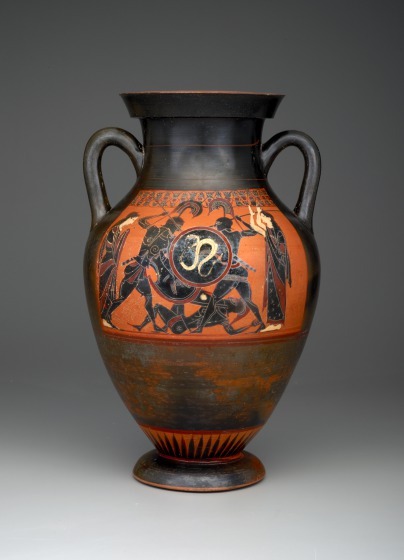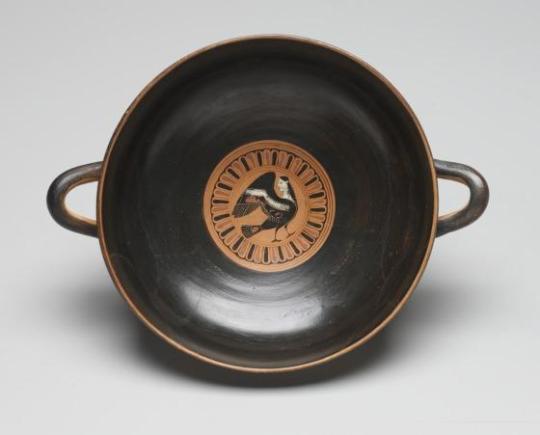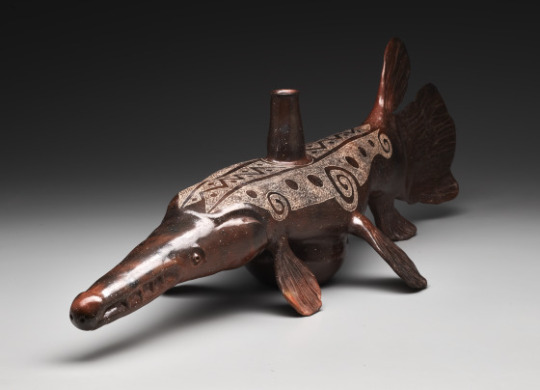#Arctinus of Miletus
Explore tagged Tumblr posts
Text

For your consideration:
King Memnon of Ethiopia
A descendant of Priam, he came to Troy's aid in the mythological Trojan War. He killed Antilochus, son of Nestor, and was himself later killed by Achilles on the behest of Nestor.
A story of Bronze Age Greece (approx 1750 – c. 1050 BC), scholars estimate the war in the legend took place about 1250 BCE. The legend was later captured by Homer around 750 BCE.
Memnon does not appear in Homer's famous The Iliad, but in another book of The Epic Cycle, The Aethiopis. This book follows The Iliad and captures the events following Hector's funeral up to Achilles' death.
Vase painting dated 460-440 BCE.
Conclusion
Africans were living in Bronze Age Greece and Classical Greece. In fact, they were common enough for at least one to be a major character in one of the most famous myths. A myth so famous that we still read and study it in 2024 CE!
If one of the main characters in The Iliad can be African, I think Diomedes and Patroclus can be African too.
#tagamemnon#The Iliad#Black Patroclus#Black Diomedes#King Memnon#the Aethiopis#Arctinus of Miletus#The Aithiopis#Greek Mythology#Black Greeks#Homer#Classical mythology#Trojan War#Epic Cycle
35 notes
·
View notes
Text
Ok so I'm trying to collect every piece of the epic cycle/ things that have to so with the Trojan war/ the characters, and thos what I have so far
Aethiopis - Arctinus of Miletus
Achilleid - Statius
Aeneid - Virgil
Ajax - Sophocles
Alcmeonis - don't know
Andromache - Euripides
Bibliotheca - Pseudo-Apollodrus
Carmina Illiaca/AnteHomerica - John Tzetez
Cyclops - Euripides
Cypria - Stasinus
*De Raptu Hellene - Draconthius
Descriptions of Greece - Pausania
Ehoiai - Hesiod
Electra - Europides
Electra - Sophocles
Epigoni - Homer(?) Antimachus of Teos(?)
Fabulae - Hyginus
Fragment 14 - Sappho
Fragment 44 - Sappho
Harpage Hellenes - Colothus
Hecuba - Europides
Helen - Europides
Heroicus - Philostratus
Homerica - John Tzetez
Iliad - Homer
Iliou Persis - Arctinus of Miletus
Iphigenia - Euripides
Iphigenia Among the Tauri - Euripides
Iphigenia in Aulis - Europides
Little Iliad - Lesches of Lesbos
Metamorphoses - Ovid
Mythographus Homericus - we don't know
Nostoi - Agias of Troizen
Odyssey - Homer
Oedipodea - Cinaethon of Sparta
Oresteia (trilogy) - Aeschylus
Orestes - Euripidies
Orestes Tragodeia - Draconthius
Philoctetes - Sophocles
Post-Homerica - John Tzetez
PostHomerica - Quintus Smyrnaeus
Rawlinson Excidium Troie -
Telegony - Eugammon of Cyrene
Trojan Women - Euripides
Tryphodorus the Taking of Illios - Epyllion
Thebaid - Homer (?)
Thebiad - Stesichorus
Tzetez Theogeny -
Vatican mythographer one -
If any of this is incorrect lmk or if there's any other you know too
#idk why im doing this#fun ig#???#tagamemnon#the iliad#the odyssey#the aeneid#the other ones#the epic cycle#the theban cycle#which probably isnt even a cycle#uhh#idkcother things#Achilles#odysseus#diomedes#menelaus#other people#corvid talks about smth#corvid rambles
110 notes
·
View notes
Photo

Laocoön: The Suffering of a Trojan Priest & Its Afterlife
The sculpture group of Laocoön and His Sons, on display in the Vatican since its rediscovery in 1506, depicts the suffering of the Trojan prince and priest Laocoön (brother of Anchises) and his young sons Antiphantes and Thymbraeus and is one of the most famous and fascinating statues of antiquity. In his Natural History, Pliny the Elder states that the Laocoön, created by the eminent Rhodian sculptors Hagesander, Polydorus, and Athenodorus, “is a work of art to be preferred to any other painting or statuary” (36.37). Among art historians, the sculptural group has received near-universal acclaim ever since its rediscovery under questionable circumstances in 1506.
Is the statue famously shown since its discovery in the newly designed Belvedere Garden at the Vatican Palace actually the ancient sculpture mentioned by Pliny, or rather a clever Renaissance forgery? If the latter, who may have contrived this masterful deception? If the former, is it an original, or a marble copy of a Hellenistic bronze made for a Roman patron?
Beware of Greeks Bearing Gifts
In the most famous version of the story, as told by Virgil (70-19 BCE) in his Aeneid, Laocoön had warned his fellow citizens against the Greeks “even if they bear gifts,” and had tried to expose the true nature of the wooden horse by striking it with a spear (the wooden horse in question, of course, being the notorious “Trojan Horse”, left by the Greek forces on the coast so as to provide access into the city to the troops hidden inside the construction). When later two serpents emerged from the sea to kill the priest and his sons, the Trojans interpreted their horrific deaths as an act of divine retribution and promptly decided to move the wooden horse into the city, believing the contraption to be an offering to Minerva (Athena).
According to Arctinus of Miletus, the earliest tradition of the tragedy (surviving only through later citations), Apollo had sent the two serpents to kill Laocoön and only one of his sons; while the later author Quintus of Smyrna maintains that the serpents killed both sons but spared the father.
Servius, another late authority (c. 400 CE), tells us how Laocoön managed to incur the wrath of Apollo by sleeping with his wife before the cult statue in the god's temple. An even later source, the Byzantine scholar Tzetzes, adds that the scene of Laocoön's death took place in the very temple of the Thymbraean Apollo – appropriately setting the punishment at the scene of the crime.
The 5th-century BCE Greek playwright Sophocles produced a tragedy on the subject, of which only a few fragments survive in later citations. Apart from the sources mentioned above, Hellenistic poets Apollodorus and Euphorion, the historian Dionysius of Halicarnassus, the Roman novelist Petronius, the Latin fables attributed to Hyginus, and a few other fragments, all provide various details of the tragic story.
Despite this appearance in ancient literature from the post-Homeric to Byzantine traditions, artistic representations of Laocoön's suffering are few and far between. Depictions appear in some Greek vase paintings (5th to 4th centuries BCE) and in two frescoes at Pompeii (c. 25-75 CE). The marble statue group of Laocoön and His Sons, therefore remains the most exceptional portrayal of only a handful of ancient works illustrating the suffering of Laocoön.
Continue reading...
65 notes
·
View notes
Text
Arctinus: I thought we were having wine.
Homer: Oh, no. I said "wine-dark sea". That's what I call the sea.
Arctinus: You call the sea "wine-dark"?
Homer: Yes. It's a regional dialect.
Arctinus: Uh-huh. What region?
Homer: Uh, Anatolia.
Arctinus: Really. Well, I'm from Miletus, and I've never heard anyone use the phrase "wine-dark sea".
Homer: Oh, not in Miletus, no. It's an Aeolia expression.
Arctinus: And you call it wine-dark despite the fact that it is obviously blue?
Homer: (nods)
21 notes
·
View notes
Text

According to Aethiopis, a Trojan War epic by Arctinus of Miletus, the remains of Achilles were brought to Snake Island (Λευκή, Leuke or White Island in Greek).
These valiant warriors have now become one with Achilles on the island, once again rendering its ground sacred.
5 notes
·
View notes
Text
Broken Art Lost Pieces (long post)
Okay I need a little rant about an accident that happen the other night. As some of you know I worked in the art museum in my city. They were hosting a private event where most doors were locked. A 21 year old broke one of the glass doors and enter the museum and damaged 5 million dollars worth of art. His reason was "he was upset with his girlfriend". The exhibit that face the most damage was the Ancient Greek Art. The Native American exhibit also suffer damages. Below are the art works that were damage. *All information is linked including the photos* (One of the pieces that was destroyed was a personal favorite).
Title: Black Figure Panel Amphora Date: Last quarter of 6th century BCE Artist: UNKNOWN

Scene shown on the amphora is from the battle of The Trojan War, the warrior Achilles is seen fighting for the fallen warrior (please don't make it about Achilles and Patroclus because it isn't) from Aethiopis, an epic poem by Homer or Arctinus of Miletus.
Title: Red-figure Pyxis with Lid: Women's Quarters Date: uncertain close to the last 5th century BCE Artist: UNKNOWN

Six figures are seen that wraps around the body container. To read the description of the six figures and the background information.
Title: Kylix Date: 550-530 BCE Artist: UNKNOWN

The kylix has a siren, women with a bird body surrounded with tongue patterns. The decorated middle zone features small vignettes of Herakles fighting the Nemean lion, flanked by elders and palmettes on each side. There are swan ornaments under the handles. This type of cup is called Siana, after a site in Rhodes where some examples of the type were found.
The last piece is from the Native American exhibit Title: Batah Kuhuh Alligator Gar Fish Effigy Bottle Date: 1976 Artist: Chase Kahwinhut Earles

On the museum website there is no information on the piece besides the generic info. From what I heard this one was shattered. The casing it was in was filled with smaller pieces that also suffer small damages. They say the damages estimate total does not include museum damages ex. doors, computers, casing, phones. To quote, DMA board member Mary McDermott Cook, "Let’s face it. It’s just things. No person was hurt. And we have the technology and the expertise to put broken things back together.’ And thank God for that.”
While that is true I am still heartbroken and disappointed that someone used their anger to destroy history.
#art#art museum#art history#damaged art#ancient greece#ancient art#greek art#trending news#art news#achilles#Native American art#history destroyed#long post
0 notes